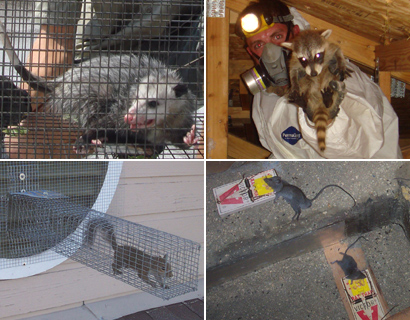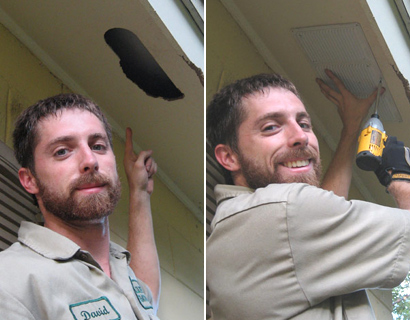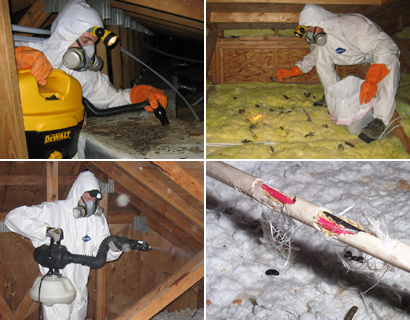- How We Solve Wildlife Problems
How We Solve Minneapolis Wildlife Problems
INSPECTION: Once on site, we will perform a full inspection of your home and property. This allows us to use the correct strategy and traps. If the animals are in an attic, a full building inspection is crucial, including the following:
- All ground-level areas, such as piper or A/C line entry & exit areas, A/C chase bottoms, ground-level vents, etc.
- All mid-level areas, such as dryer vents, siding gaps, first floor eaves or dormers, etc.
- We inspect the entire roof, including all plumbing stacks, ridge caps, vents, and other potential gaps or holes.
- We also inspect inside your attic, to identify animals and damage they have caused.
- If the animals are outside, we notice many subtle clues that will assist us in a successful strategy.
TRAPPING, EXCLUSION, REMOVAL: Once we understand what animal species we are dealing with, and the problem, we use the most effective means of removing the animals. We use dozens of different types of traps.
- Trapping - If trapping the animal(s) in live cage traps, trap type, set, and location are crucial to success.
- Exclusion - Oftentimes, we are able to simply set one-way doors or other exclusion devices that allow the animals inside a building to safely exit, but never get back inside.
- Removal By Hand - Sometimes we actually remove animals by hand, or with special tools like snare poles.
- The Law - In all cases, we obey state and local laws regarding wildlife, but aim to take the most humane approach.
ENTRY HOLE REPAIRS: Repairs are a crucial step in the wildlife removal process. In many cases, such as bat or rodent control, the job cannot be performed without detailed repairs, and in all cases, sealing the entry holes shut ensures that no future wildlife will ever enter your home.
- 100% of the entry holes must be found, and sealed shut, or the job is not complete.
- Our repairs are professional contractor grade, look good, and when applicable we use steel, which rodents such as rats or squirrels are unable to chew through.
- We give a written guarantee on our repairs against any future animal entry.
ATTIC DECONTAMINATION SERVICES: It may be desirable to clean your attic after we've removed the animals. They can leave behind large amounts of droppings, urine, hair, oils, food, nesting material, and so on. These remnants can attract insects like cockroaches, and the scent left behind can encourage new animals to chew their way into your house. You might experience odor problems from the waste. It's possible that mold will grow on waste areas.
- We remove or vacuum all droppings, or remove all the soiled insulation.
- We fog the attic with a special enzyme-based cleaner that destroys any organic matter and deodorizes the space.
- We repair damage, such as ductwork, electrical wires, pipes, insulation, and more.
As a northern midwestern state, our primary nuisance wildlife species are raccoons, squirrels, skunks, groundhogs, moles, and mice. We also have many colonies of bats, both Little Brown and Big Brown. We deal with snakes in the summer, mostly harmless ones. In our lovely winters we do handle squirrels in attics, and some activity by other animals. We service the greater Minneapolis and Saint Paul area, including Hennepin County, Ramsey County, Dakota County, Anoka County, and Washington County. We service the surrounding towns of Bloomington, Brooklyn Park, Plymouth, St. Cloud, Woodbury, Eagan, Maple Grove, Eden Prairie, Coon Rapids, Burnsville, Blaine, Lakeville, Minnetonka, Apple Valley, Edina, St. Louis Park, Maplewood, Shakopee, Richfield, Cottage Grove, Roseville, and more. We will travel farther for several projects, so if in doubt, just give us a call! We look forward to hearing from you. Go back to the Minneapolis wildlife control home page.
This month's wildlife how-to article: Opossum prevention
How to keep opossums away from your house and yard - Opossums may look cute, but in reality, they can be a real pain in the backside! With a heritage that dates back to dinosaur times, these critters have some remarkable ways of dealing with life, and seem to have adapted very well to ensure their continuation in life. They can play dead, eat almost any food source that is thrown at them, and have an amazing ability to produce so many young at once; they are guaranteed to survive in one way or another.
It is all of these things combined that make it incredibly hard to get rid of opossums once they have made your yard their home. Starting with diet, you can’t even use this as an opossum preventative method. With most wildlife problems, once you eliminate a food source, the animal pretty much gives up and moves along, but from the opossum diet, you can understand why this is so difficult.
As well as eating the things that we humans would eat, opossums also love snails, bugs, beetles, plant roots and much more. This means that even if you keep food out of the garbage can, and never leave dog or cat food on your porch, you are still likely to encounter a problem. If you take away the human food, the creature will still go for the bugs in your yard, and there really isn’t anyway that you can prevent those from getting in there!
We now to come to “playing dead”. These creatures have a habit of rolling over and seeming to be dead when they are feeling threatened or feel they are going to be harmed in anyway. This can be confusing and a bad situation for both humans and opossums; the creature could be disposed of before it has a chance to wake up, and the human could feel as if they have gotten rid of the problem, not realizing that the animal is still actually alive.
Babies, babies, babies! When an opossum mother has babies, she can have up to 25 of the little critters. And no, that is not a typo; the average litter of this creature is between 5 and 25! If you have a pregnant opossum in your yard, you could potentially have 25 times the problem before you even realized it!
The best way that you can look into opossum prevention is by calling a company that specializes in wildlife control. They will educate you and even make changes to your home and yard to ensure that the opossum leaves and stays out, and at the same time, they will also trap any of the critters that are around and release them safely back into the wild to carry on with their life. There are, of course, methods that you can use, such as putting four foot high chicken mesh wire around your property to keep the little critters out, but in reality, this will not only prove to be rather time consuming, but also rather expensive, especially if you have a rather large yard!
Other Minneapolis animal pest control topics:
How to Get Rid of Skunks
Bat Repellent
Groundhog Biology and Information
Raccoon Prevention Tips





